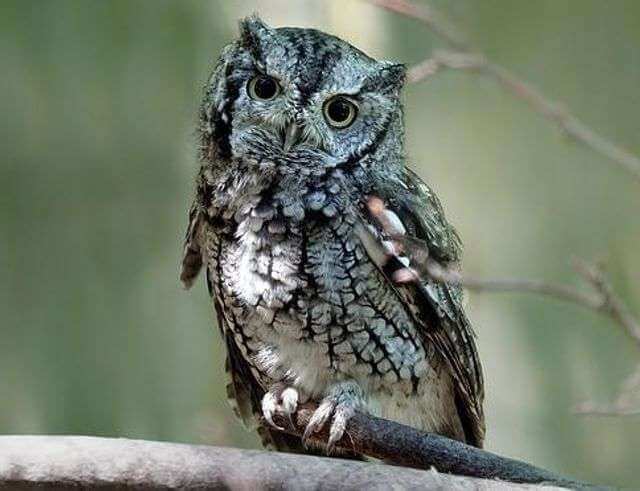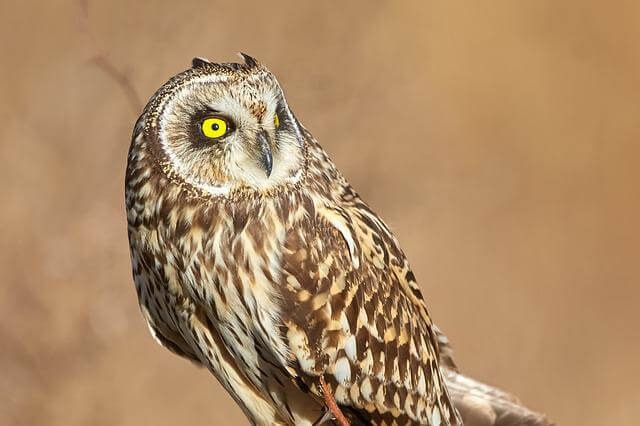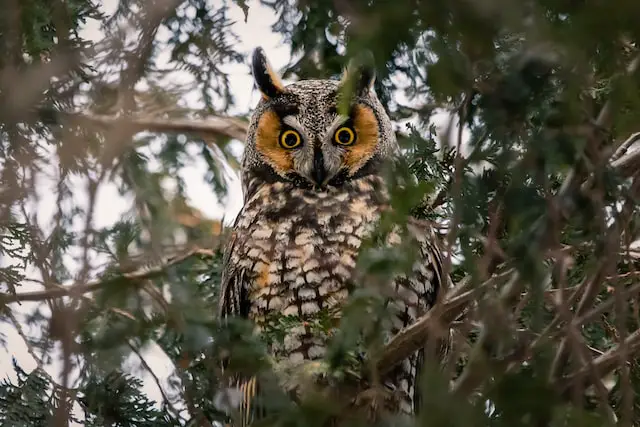Louisiana’s rich tapestry of wetlands, forests, and bayous is not only a paradise for outdoor enthusiasts but also a habitat for a diverse array of wildlife. Among the most captivating creatures that call Louisiana home are its majestic owls.
With their haunting calls and silent flights, these nocturnal hunters hold a special place in the hearts of nature lovers. In this guide, we’ll introduce you to nine unique types of owls found in Louisiana, exploring their habitats, behaviors, and the fascinating characteristics that make each species distinct.
Table of Contents
Types of Owls In Louisiana
Barred Owl
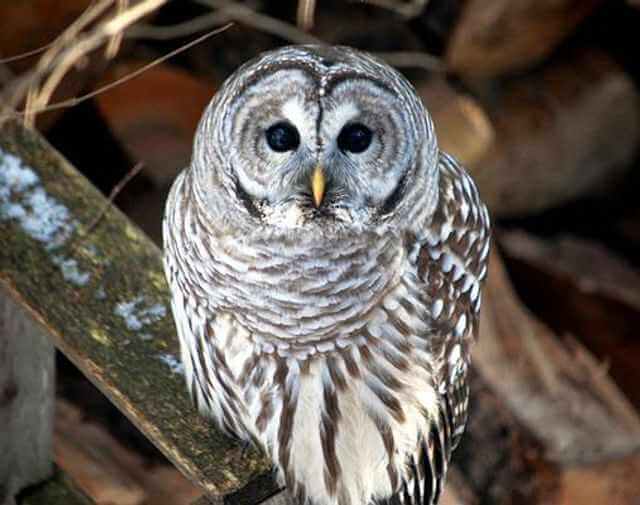
- Length: 16.9-19.7″ in (43-50 cm)
- Weight: 16.6-37.0 oz. (470-1050 g)
- Wingspan: 39.0-43.3″ in (99-110 cm)
- Scientific Name: Strix varia
- Frequency of Occurrence: 5.46% (Statistic by: eBird)
- Maps: Range Map – Sightings Map
- Sounds: Calls
- Where To Find Them: The Barred Owl is found throughout Louisiana in a variety of habitats. In the winter, they are found in hardwood and mixed forests, while in the summer they are found in swamps and bayous. They are also occasionally seen in urban areas.
General Information: The Barred Owl is a large owl with a round head and no ear tufts. It has dark brown eyes, a yellow beak, and a white facial disc. The upper parts are brown with white streaks, while the underparts are white with brown streaks. The wings are short and rounded. The tail is long and square-ended. This owl is found in woods of all types, including deciduous, coniferous, and mixed forests.
It prefers areas with dense vegetation, such as overgrown fields or swampy woods. The Barred Owl is also found in urban areas, including parks and suburbs. This owl eats small mammals, such as mice and voles. It also eats birds, reptiles, amphibians, and insects. The Barred Owl hunts at night by perching on a branch and waiting for prey to come within range.
Great Horned Owl

- Length: 17.7-24.8 in (45-63 cm)
- Weight: 32.1-88.2 oz. (910-2500 g)
- Wingspan: 39.8-57.1 in (101-145 cm)
- Scientific Name: Bubo virginianus
- Frequency of Occurrence: 2.28%
- Maps: Range Map – Sightings Map
- Sounds: Calls
- Where To Find Them: Most of the year, Great Horned Owls are found in Louisiana’s woodlands. They like to perch in trees near the edge of a forest, where they have a good view of the surrounding area. In the winter, they may be found in swamps and bayous.
General Information: The Great Horned Owl is a large owl of the typical owl family. Highly adaptable, it is found in all kinds of habitats including deserts and forests. The Great Horned Owl has a large range, extending from northern Alaska and Canada to as far south as Tierra del Fuego. In North America, it is found in both forest and Desert habitats; in South America, it inhabits mainly Andean mountain forests.
This owl is also found on Caribbean islands such as Cuba and Hispaniola. The Great Horned Owl’s diet consists mostly of small mammals such as rabbits, rodents, and hares. However, they will also eat birds up to the size of ducks. Owls hunt primarily at night using their excellent hearing to locate their prey.
Related: 35 Fun Facts About The Great Horned Owl (Detailed)
Eastern Screech Owl
- Length: 6.3-9.8″ in (16-25 cm)
- Weight: 4.3-8.6 oz. (121-244 g)
- Wingspan: 18.9-24.0″ in (48-61 cm)
- Scientific Name: Megascops asio
- Frequency of Occurrence: 1.78%
- Maps: Range Map – Sightings Map
- Sounds: Calls
- Where To Find Them: The Eastern Screech Owl is found in various locations throughout Louisiana, though they are considered quite rare. They typically make their homes in wooded areas near streams or other water sources, and can often be seen perching on branches or hunting for prey.
General Information: The Eastern screech owl is a small owl found in wooded areas of eastern North America. These owls are nocturnal predators, hunting for small mammals and birds. Screech owls live in a variety of habitats, including forests, swamps, and even urban areas. Screech owls are relatively small owls, with a body length of about 10 inches.
They have large eyes and ear tufts, and their plumage is reddish brown and white. These owls are well-camouflaged against the bark of trees, making them difficult to spot. Eastern screech owls primarily eat small mammals such as mice and voles. They will also feed on birds, reptiles, and insects. Screech owls hunt at night, using their excellent hearing to locate prey.
Barn Owl
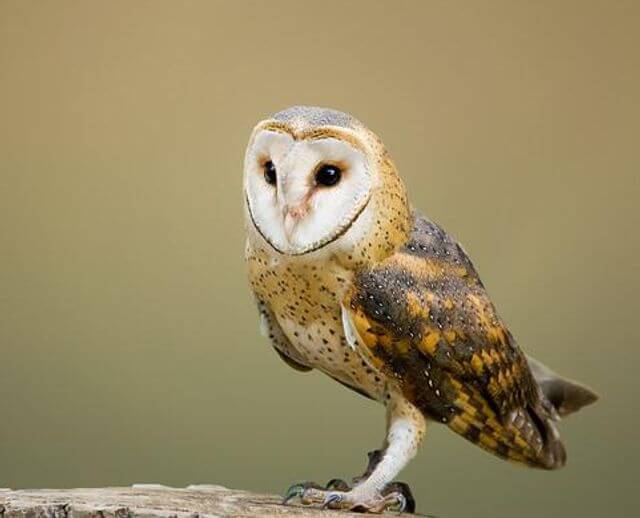
- Length: 12.6-15.8″ in (32-40 cm)
- Weight: 14.1-24.7 oz. (400-700 g)
- Wingspan: 39.4-49.2″ in (100-125 cm)
- Scientific Name: Tyto alba
- Frequency of Occurrence: 0.3982%
- Maps: Range Map – Sightings Map
- Sounds: Calls
- Where To Find Them: The barn owl is a very rare sight in Louisiana, but there have been a few recent sightings. These birds are most often found in rural areas, near farms, or open fields. They typically nest in trees or on cliffs, but can also be found in old barns or abandoned buildings.
General Information: The barn owl is a bird of prey that can be found in many different parts of the world. The most common place to find them is in Europe, but they can also be found in North and South America, Asia, and Africa. They prefer to live in open areas like fields or forests, but can also be found in more urban areas.
Their diet consists mostly of small mammals like rats and mice, but they will also eat birds, reptiles, and insects. They are nocturnal hunters and use their excellent hearing to locate their prey. Barn owls are one of the most common types of owls in the world and are a valuable asset to farmers as they help keep rodent populations under control.
Short-eared Owl
- Length: 13.4-16.9 in (34-43 cm)
- Weight: 7.3-16.8 oz. (206-475 g)
- Wingspan: 33.5-40.5 in (85-103 cm)
- Scientific Name: Asio flammeus
- Frequency of Occurrence: 0.0481%
- Maps: Range Map – Sightings Map
- Sounds: Calls
- Where To Find Them: The Short-eared Owl is a very rare bird that is occasionally seen in Louisiana. They typically inhabit open areas such as grasslands, meadows, and marshes. In Louisiana, the best places to see this owl are in the northern part of the state near Lake Pontchartrain and in the southernmost region near New Orleans.
General Information: The Short-eared Owl is a medium-sized species. Its head is rounded and has no ear tufts. Its eyes are yellow and it has a black bill. The upper parts are brown with white spots, and the lower parts are pale with dark streaks. The legs are very long, and its feet are feathered. The wings are long and narrow.
Short-eared Owls breed in open areas such as tundra, prairies, meadows, and marshes. They nest on the ground, usually in a depression lined with grasses and feathers. They sometimes use old nests of other birds such as gulls, ravens, or hawks. Short-eared Owls eat mostly small mammals such as voles, lemmings, mice, and shrews. They will also eat birds, reptiles, insects, and amphibians.
Burrowing Owl
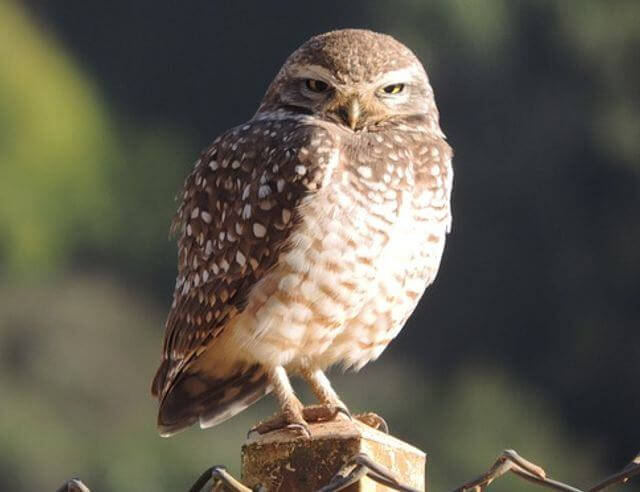
- Length: 7.5-9.8″ in (19-25 cm)
- Weight: 5.3 oz. (150 g)
- Wingspan: 21.6″ in (55 cm)
- Scientific Name: Athene cunicularia
- Frequency of Occurrence: 0.0228%
- Maps: Range Map – Sightings Map
- Sounds: Calls
- Where To Find Them: In Louisiana burrowing owls are fairly rare, and are found in areas with tall, dense grasses and short trees. These areas are usually near water sources, such as lakes, rivers, and marshes. The owls use the tall grasses for cover and the short trees for perching and nesting.
General Information: The burrowing owl is a small, long-legged owl found throughout North and South America. The owl gets its name from its habit of nesting in burrows, often those abandoned by other animals such as prairie dogs. Burrowing owls are somewhat unusual among owls in that they are active during the day as well as at night. The burrowing owl has a relatively short tail and wings, and a round head with no ear tufts.
The adult owl is about 10 inches long and weighs about 5 ounces. The female is usually slightly larger compared to the male. Burrowing owls are brownish-gray above and light gray below, with white spots on the wings and back. They have large eyes surrounded by dark feathers, which help to reduce glare when hunting during the day.
Related: Really Cool Burrowing Owl Facts That Will Amaze You!
Long-eared Owl
- Length: 13.8-15.8 in (35-40 cm)
- Weight: 7.8-15.3 oz. (220-435 g)
- Wingspan: 35.4-39.4 in (90-100 cm)
- Scientific Name: Asio otus
- Frequency of Occurrence: 0.0021%
- Maps: Range Map – Sightings Map
- Sounds: Calls
- Where To Find Them: The long-eared owl is a rare find in Louisiana, but there are a few spots where they have been known to reside. These owls are nocturnal predators, so they are often difficult to spot during the day. They prefer to hunt in open areas with plenty of prey, so they are typically found in woodlands or near fields.
General Information: The long-eared owl is a medium-sized owl with large ear tufts. They are most frequently discovered in North America, Europe, and Asia. They are commonly found in forests and woodlands. Their primary food is small animals as well as birds. The long-eared owl has a large range, spanning from North America to Europe and Asia. They are most commonly found in forests or woodlands, where they can perch on branches and hunt for their prey.
These owls primarily eat small mammals and birds, which they capture with their sharp talons. While the long-eared owl is not currently considered threatened or endangered, their populations have declined in some areas due to habitat loss and fragmentation. However, overall this species is doing well and can be found in many different parts of the world.
Flammulated Owl
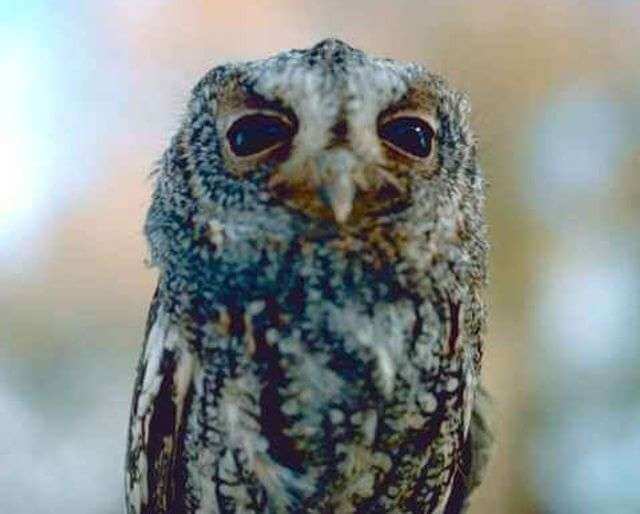
- Length: 5.9-6.7 in (15-17 cm)
- Weight: 1.5-2.2 oz (43-63 g)
- Wingspan: 15.9-16.1 in (40.5-41 cm)
- Scientific Name: Psiloscops flammeolus
- Frequency of Occurrence: 0.0003%
- Maps: Range Map – Sightings Map
- Sounds: Calls
- Where To Find Them: Flammulated owls are a rare sight in Louisiana, but they can be found in certain areas if you know where to look. These small owls are most often seen in forests near the coast, and they tend to stick to areas with dense vegetation. If you’re lucky enough to spot one of these rare birds, you’ll likely see it perched on a branch or hunting for prey at night.
General Information: The Flammulated Owl is found in North America, specifically in the western United States and Mexico. These nocturnal predators can be found in a variety of habitats, including forests, mountains, and deserts. Their diet consists primarily of small mammals and insects.
However, they have been known to eat other small birds as well. Because they are such efficient predators, they help to keep the populations of their prey in check. Flammulated Owls are important members of the ecosystem and play a vital role in keeping it healthy and balanced.
Snowy Owl

- Length: 20.5-27.9 in (52-71 cm)
- Weight: 56.4-104.1 oz. (1600-2950 g)
- Wingspan: 49.6-57.1 in (126-145 cm)
- Scientific Name: Bubo scandiacus
- Frequency of Occurrence: 0.0001%
- Maps: Range Map – Sightings Map
- Sounds: Calls
- Where To Find Them: The Snowy Owl is a rare bird that can be found in Louisiana. These beautiful creatures are most often found in the northern parts of the state, near Lake Pontchartrain. However, they have also been spotted in other areas, such as Baton Rouge and New Orleans.
General Information: The Snowy Owl is a large, white owl of the true owl family. Snowy Owls are native to Arctic regions in North America and Eurasia. These regal birds are easily recognizable by their round heads and white plumage with black bars. They have yellow eyes and strong, curved talons.
The Snowy Owl is a ground nester that relies heavily on lemmings for food. During the non-breeding season, they may also eat other small mammals such as voles, shrews, and rabbits; as well as birds such as ptarmigan, ducks, and geese. The availability of prey largely determines the snowy owl’s breeding success or failure.
Related: 48 Fun Facts About Snowy Owls (Full Guide with Photos!)


